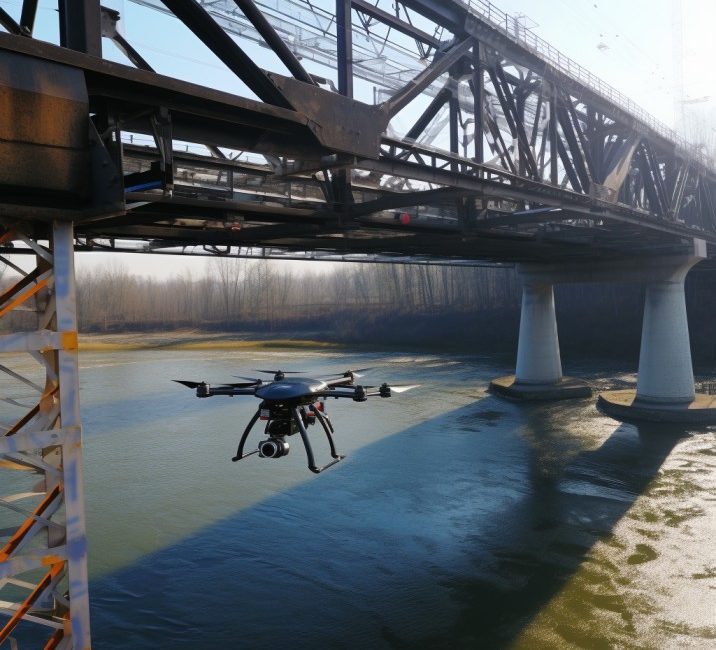Inspecting critical infrastructure such as bridges, towers, and pipelines is a challenging and time-consuming task that often involves risks to personnel and high costs. However, with the advancements in drone technology, infrastructure inspections have become safer, more efficient, and cost-effective. Drones offer unique capabilities that make them ideal tools for inspecting these structures. In this article, we will explore how drones are being used for infrastructure inspection, the benefits they provide, and the various ways they are revolutionizing this field.
1. Enhanced Safety
One of the primary advantages of using drones for infrastructure inspection is the enhanced safety they offer. Traditional inspection methods often involve sending personnel to heights or hazardous locations, putting them at risk. Drones eliminate the need for human inspectors to physically access these areas, reducing the potential for accidents and injuries. By utilizing drones, inspection teams can conduct thorough inspections from a safe distance, minimizing the risks associated with working at heights or in dangerous environments.
2. Efficient Data Collection
Drones equipped with high-resolution cameras and sensors can capture detailed imagery and data of infrastructure elements. They can easily navigate around structures, capturing images of critical components and areas that are difficult to access manually. This efficient data collection allows inspectors to obtain a comprehensive view of the infrastructure, identifying potential issues or defects. The data collected by drones can be analyzed and processed to generate accurate reports, enabling informed decision-making and facilitating maintenance or repair planning.
3. Cost-Effectiveness
Infrastructure inspection using drones is a cost-effective solution compared to traditional methods. The use of drones eliminates the need for expensive equipment, such as scaffolding or cranes, and reduces labor costs associated with manual inspections. Drones can cover large areas in a relatively short amount of time, reducing the overall inspection duration and minimizing disruption to operations. Additionally, the ability to detect issues early through drone inspections can prevent costly repairs or even catastrophic failures, resulting in long-term cost savings.
4. Access to Inaccessible Areas
Drones are particularly effective in inspecting infrastructure elements that are difficult to access manually. Bridges with intricate designs, tall towers, or remote pipelines can be challenging to inspect using traditional methods. Drones can navigate these structures with ease, capturing detailed imagery and data from various angles. Their maneuverability allows them to reach areas that would be otherwise inaccessible or require significant time and resources to access. By providing access to these inaccessible areas, drones enable thorough inspections and early detection of potential issues.
5. High-Quality Imaging and Sensors
The advancements in drone technology have led to the development of high-quality cameras and sensors. Drones can capture high-resolution imagery and videos, allowing inspectors to zoom in on specific areas of interest and detect even minor defects or signs of deterioration. Thermal imaging sensors can also be incorporated into drones, enabling the detection of heat anomalies that may indicate potential structural issues. These imaging and sensor capabilities provide valuable insights into the condition of infrastructure, helping inspectors make informed decisions about maintenance or repair requirements.
6. Rapid Deployment and Real-Time Monitoring
Drones can be rapidly deployed to inspect infrastructure, saving time and reducing disruption to operations. They can be launched quickly and cover large areas efficiently, providing timely data for assessment. In addition, some drones offer real-time monitoring capabilities, allowing inspectors to view live feeds of the inspection as it happens. This real-time monitoring enables immediate identification of critical issues, providing an opportunity for prompt action and minimizing downtime or potential risks.
7. Documentation and Reporting
Drones simplify the documentation and reporting process for infrastructure inspections. The data collected by drones can be easily stored, organized, and analyzed using specialized software. This data can then be used to generate comprehensive reports, complete with detailed imagery, annotations, and observations. These reports provide a clear overview of the infrastructure’s condition, including any identified issues or areas requiring attention. The documentation and reporting capabilities of drones streamline the inspection process and facilitate communication among stakeholders, such as engineers, maintenance teams, or regulatory authorities.
Conclusion
Drones have revolutionized infrastructure inspection by offering enhanced safety, efficient data collection, cost-effectiveness, and access to inaccessible areas. With their high-resolution imaging capabilities, rapid deployment, and real-time monitoring, drones provide invaluable insights into the condition of bridges, towers, and pipelines. By utilizing drones, inspection teams can detect issues early, make informed decisions based on accurate data, and plan maintenance or repairs efficiently. As drone technology continues to advance, we can expect even more innovative solutions and improvements in infrastructure inspection, ensuring the safety and reliability of critical structures.





